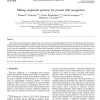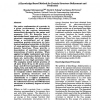294 search results - page 4 / 59 » Predicting the beta-helix fold from protein sequence data |
JBI
2008
13 years 7 months ago
2008
Protein data contain discriminative patterns that can be used in many beneficial applications if they are defined correctly. In this work sequential pattern mining (SPM) is utiliz...
BMCBI
2008
13 years 7 months ago
2008
Background: Residue depth allows determining how deeply a given residue is buried, in contrast to the solvent accessibility that differentiates between buried and solvent-exposed ...
ISMB
1996
13 years 8 months ago
1996
The native conformation of a protein, in a given environment, is determined entirely by the various interatomic interactions dictated by the amino acid sequence (1-3). We describe...
BMCBI
2005
13 years 7 months ago
2005
Background: A large number of papers have been published on analysis of microarray data with particular emphasis on normalization of data, detection of differentially expressed ge...
BMCBI
2005
13 years 7 months ago
2005
Background: Predicting the subcellular localization of proteins is important for determining the function of proteins. Previous works focused on predicting protein localization in...


